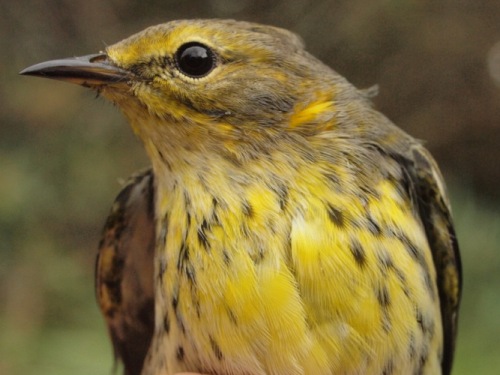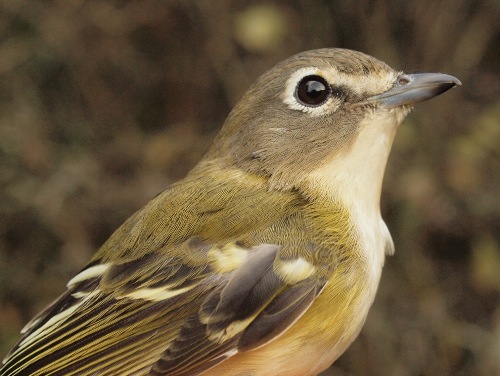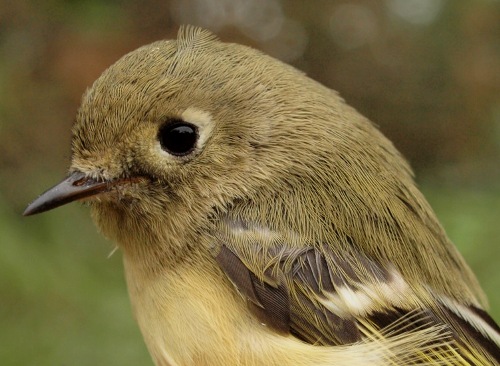|
Week 8: September 19-25, 2014 |
Welcome
to the McGill Bird Observatory weekly report.
Click here for a complete listing of our archives.
Comments or
questions are welcome at "mbo AT migrationresearch.org".
|
PICTURE
OF THE WEEK: |
|

Although Cape May Warblers were abundant in parts of Quebec this summer (most
notably the Saguenay region), numbers passing through MBO this fall have been
rather modest, with only 10 individuals banded to date, compared to last year's
record total of 45.
(Photo by Simon Duval)
-
|
|
|
THIS WEEK |
THIS FALL |
2014 TOTAL |
SITE TOTAL |
|
# birds (and species) banded |
323 (39) |
1916 (69) |
3415 (84) |
49725 (115) |
|
# birds (and species) repeat |
48 (16) |
458 (40) |
797 (53) |
9931 (70) |
|
# birds (and species) return |
5 (4) |
44 (17) |
184 (31) |
1618 (38) |
|
# species observed |
84 |
129 |
154 |
209 |
|
# net hours |
516.0 |
4111.0 |
7524.4 |
86707.7 |
|
# birds banded / 100 net hours |
62.6 |
46.6 |
45.4 |
57.3 |
|
|
Note: table does not include nocturnal banding (owls) |
|
Banders-in-charge: Simon Duval and Gay Gruner
Assistants: Angelika Aleksieva, Nicolas Bernier, Sue Bishop, Marc Boisvert, Cindy Bouchard, Manon Bourdon, Iain Caldwell, Luke Currin, David Davey, Jean Demers, Nathalie Gendron, Pedro Grillo, Alison Hackney, Lisa Keelty, Marcel Lebeau, Catherine Legault, Betsy McFarlane, Ana Morales, Ahmad Shah, Marilou Skelling, Clémence Soulard, Elise Titman, Rodger Titman, Christiane Tremblay, Jay VanderGaast
Notes:
In four of the past five years, week 8 has unfolded relatively modestly, with between 205 and 252 birds banded during the week (the one notable exception being in 2010 when the total rose to an incredible 1279 thanks to an unprecedented influx of Yellow-rumped Warblers). As such, the 323 birds banded this week was more than we were expecting, though far short of being a record. Overall, the total for the season is hovering near our average pace, but with migration picking up this week, there is plenty of time yet for the numbers to grow. As with most of the season, the number of species observed this week was also somewhat above average.

As banders, we always have to be aware of the potential for rarities - including some that differ only in subtle ways from more common species. This Blue-headed Vireo had us thinking about Cassin's Vireo for a bit, due to the greenish head and back, but the contrast between the cheek and throat was enough to convince us it was just a somewhat differently coloured variant of our "regular" vireo.
(Photo by Simon Duval)
|
Our first Pine Siskin sighting of 2014 came on September 23; additionally, Brown Creeper, Fox Sparrow, and White-crowned Sparrow were spotted for the first time this fall. The only species banded for the first time this year was Palm Warbler, while Brown Creeper, Golden-crowned Kinglet, and White-crowned Sparrow were new for the season.
This week’s top 10 [last week's rank in brackets]
# individuals banded |
mean # individuals observed daily |
1. White-throated Sparrow (66) [5] |
1. Canada Goose (601) [2] |
2. Magnolia Warbler (42) [1] |
2. Common Grackle (198) [3] |
3. Ruby-crowned Kinglet (21) [-] |
3. European Starling (124) [1] |
4. Blue Jay (17) [-] |
4. White-throated Sparrow (57) [-] |
5. Swainson's Thrush (16) [-] |
5. Red-winged Blackbird (44) [7] |
6. Nashville Warbler (15) [2] |
6. Blue Jay (40) [8] |
7. Golden-crowned Kinglet (14) [-] |
7. American Crow (39) [4] |
8. Yellow-rumped Warbler (12) [-] |
8. American Robin (30) [9] |
8. Black-throated Blue Warbler (12) [-] |
9. Black-capped Chickadee (16) [-] |
10. Red-eyed Vireo (10) [3]
|
10. Ring-billed Gull (12) [-] |
|
There was a drastic change this week in the top ten species banded, with only four of last week’s species carrying over. For the third year in a row, White-throated Sparrow was the dominant species in week 8. Magnolia Warbler filled that spot in 2011, but after leading the way at MBO for the past couple of weeks, dropped to second place this week. Last week’s runner-up, Nashville Warbler, dropped to sixth place this week, and Red-eyed Vireo dropped from third place to tenth – though the additional 10 individuals banded this week were enough to result in a new fall record, passing the 117 banded in our first full fall season in 2005. Meanwhile, Yellow-rumped Warbler was the top species for week 8 by a wide margin in each of 2006, 2008, and 2010 – though not even in the top ten for the week the past two years! This year was a bit in between, with just enough banded to show up in the lower half of the list. Among the other newcomers to the top ten this week were the two kinglets, arriving right on schedule; Blue Jay, moving in big numbers this fall; and Black-throated Blue Warbler, a species that has a protracted migration through MBO but rarely is in large enough numbers to crack the top ten in any given week.
With respect to birds observed, Canada Goose rose to top place this week, with a mean daily count of over 600 individuals. This is the sixth time in the past seven years that Canada Goose has been the top species in week 8; the only exception was in 2010 when the Yellow-rumped Warbler invasion was strong enough to propel that species ahead of the geese. However, the past four years the goose numbers have been lower at this time of year (mean daily counts of 93 to 283). Common Grackle flocks were also surprisingly large this week. Usually the species peaks later in fall – in the past four years, grackles were never in the top ten during week 8, let alone near the top of the list. However, back in 2005, we had a higher mean daily count (334) during this week, so their appearance at this time is not unprecedented. Joining the grackle invasion were the European Starlings, also earlier than normal – only three times before have we noted them in the top ten in week 8, and the previous high mean daily count was one-quarter of this year’s level (31 vs. 124). Not surprisingly, there were also Red-winged Blackbirds mixed in with the grackles and starlings, in above-average numbers for late September. Corresponding to the influx of White-throated Sparrows banded, the number observed daily rose to an average of 57 – similar to the numbers we observed in week 8 in 2010 and 2012, but much higher than in all other years. Similarly, Blue Jay numbers are typically quite predictable at this time of year (mean daily counts between 18 and 26 in 7 of 9 previous years), but were roughly three times higher in 2010 and 2012, and close to double this year … just enough to be marginally more abundant this week than American Crow. Rounding out this week’s top ten were American Robin, Black-capped Chickadee, and Ring-billed Gull.
|

September is a great time for studying sparrows - in this case we have a line-up (from left to right) of White-crowned, White-throated, Swamp, and Lincoln's.
(Photo by Simon Duval)

Everyone is always happy to see the return of the charismatic Golden-crowned Kinglets...
(Photo by Simon Duval)

...as well as their somewhat less flashy, but no less charming relative, the Ruby-crowned Kinglet.
(Photo by
Simon Duval)
|





